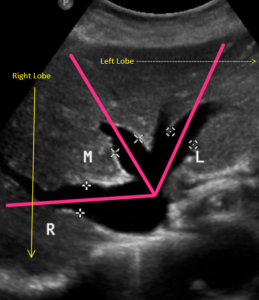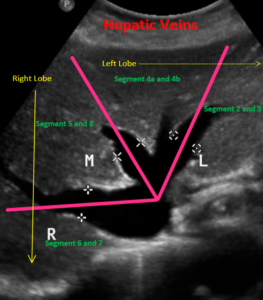The first day you put your hand on a probe you may be introduced to the largest organ in the peritoneum, the liver. The liver consists of 3 lobes (right, left, and caudate) divided into 8 segments (I, II, III, (IVa & IVb), V, VI, VII, and VIII). The hepatic veins divide the liver into parts or segments (Image A and B). If you can get the “bunny” or “reindeer” sign you have successfully located several if not all hepatic veins (pink lines in images) that are draining into the IVC (inferior vena cava).
How to get the bunny/reindeer image: Place your probe in the epigastric area with the notch pointed toward the patient’s right (transverse view) angle up into the liver above the pancreas until you connect the linear anechoic HVs to the circular IV and wha-la there you have it!!
What does the size of the HVs tell you? The size of the hepatic veins and IVC can indicate hepatic congestion and elevated right heart pressure. You should seen a tampering in size as the hepatic veins travel farther into the liver. They will be wider near the IVC.
The middle hepatic vein (MHV) divides the liver into right and left lobes. The LHV (left hepatic vein) divides the liver into medial and lateral segments. The right hepatic vein divides the right lobe of the liver into anterior and posterior segments. Knowing the segments of the liver will assist you greatly in locating pathology seen on other imaging modalities. It will also allow you to appear “nerdy” in the eyes of your radiologist. (Sonographers are nerdy!) Nothing is better than writing a preliminary report describing the characteristics of a lesion and including the segment of the liver in which it is located. This also helps future sonographers to locate the area quickly during follow-up ultrasound exams.


Think beyond the waves. There’s a lot more to sonography than just scanning!!
Yonella